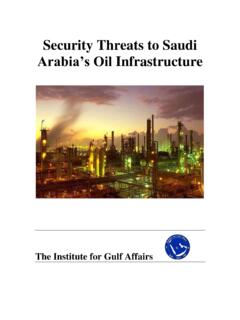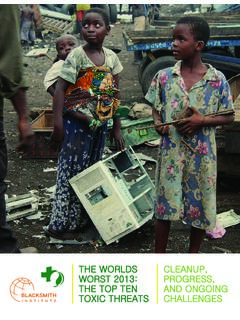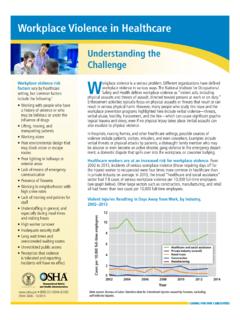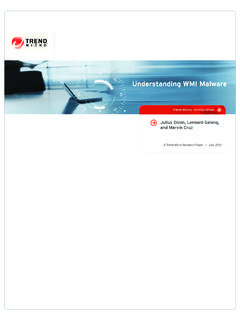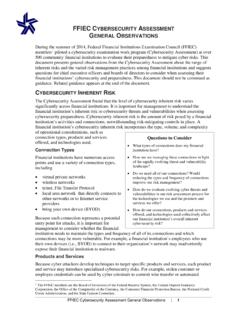Transcription of Understanding the hazards and threats - who.int
1 38 5 Understanding the hazards and threats Having described the water supply and produced flow diagrams in order to represent the supply in a logical and easily understood way, the next step is to conduct a hazard analysis in order to establish what requires controlling in order to provide safe drinking-water. HAZARD IDENTIFICATION hazards may occur or be introduced throughout the water system, from catchment to consumer. Effective risk management, therefore, requires identification of all potential hazards , their sources, possible hazardous events and an assessment of the risk presented by each. The hazard identification step, therefore, requires the water safety plan team to consider all potential biological, physical, chemical and radiological hazards that could be associated with the water supply.
2 The team should start with the water sources, then progress through the validated flow diagram. At each step the objective is to: identify what could happen to lead to contamination; and the associated control measures for A hazard is any biological, chemical, physical or radiological agent that has the potential to cause harm. A hazardous event is an incident or situation that can lead to the presence of a hazard (what can happen and how). Risk is the likelihood of identified hazards causing harm in exposed populations in a specified timeframe, including the magnitude of that harm and/or the consequences. 39each hazard. The water safety plan team should also consider influencing factors such as: variations due to weather; accidental or deliberate contamination; pollution source control practices; wastewater treatment processes; drinking-water treatment processes; receiving and storage practices; sanitation and hygiene; distribution maintenance and protection practices; and intended consumer use (see section ).
3 Biological hazards These hazards include frank and opportunistic pathogens such as: bacteria; viruses; protozoa; and helminths Other, non-pathogenic organisms that influence the acceptability of drinking-water should also be considered. These include Asellus and Cyclops. It is not necessary or practical to completely eliminate microorganisms from drinking-water supply systems. What is required is to keep numbers of pathogens below levels determined to represent an acceptable level of risk as outlined in the water quality targets (see section ). Pathogens in water supply systems generally originate from human or animal faecal material contaminating raw water or that finds its way into the water supply delivery system.
4 Common sources of faeces include wildlife such as birds, grazing animals and vermin in and around reservoirs, backflow from unprotected connections and sewer cross connections (Clark et al. 1993). Chemical hazards A chemical hazard can be considered as any chemical agent that may compromise water safety or suitability, as shown in Table Table : Examples of chemical hazards that may occur in drinking-water supply systems. Chemicals from watershed/ catchment Chemicals from reservoir storage Chemicals from water treatment processes Chemicals from distribution Nitrate Arsenic Fluoride Pesticides Algal toxins Cleaners Liner chemicals Lubricants Flocculants pH adjusters Disinfection by-products Copper Lead Cleaners Petroleum 40 Chemicals from watershed/ catchment Chemicals from reservoir storage Chemicals from water treatment processes Chemicals from distribution Other heavy metals Organic toxicants Herbicides Rodenticides Pesticides Herbicides Impurities in treatment chemicals products Liner chemicals Physical hazards Physical hazards may affect water safety by posing a direct risk to health ( through choking)
5 , through reducing the effectiveness of treatment and in particular residual disinfectants or because consumers find the water unacceptable and use alternative, more contaminated water sources. The most common physical hazard in water is sediment within the water supply. Sediments and particulates can also include pipe materials, pipe liner materials, sloughed biofilms or iron and manganese films. Suspended or resuspended sediments can contain toxic chemicals or can have pathogens attached and can co-transport other hazards . Radiological hazards Radiological contamination of drinking-water generally occurs as a result of contamination by man-made sources of radiation. Contamination can arise from: naturally occurring radioactive species in drinking-water sources; the contamination of water from the mining industry; and radionuclides from the medical or industrial use of radioactive materials.
6 HAZARDOUS EVENTS Once hazards are listed it is important to consider the corresponding events that lead to their entry into the drinking-water supply. These might be termed hazardous events or hazard causes. Hazardous events can cause contamination directly and indirectly. For example, pathogens can enter water supplies directly from faeces. However, cyanobacterial toxins result from growth of toxigenic cyanobacteria which are in turn promoted by a combination of factors. Therefore, factors, such as nutrients, which can promote cyanobacterial proliferation, can lead to water becoming unsafe and should be considered as contributory factors leading to the presence of a hazard. These contributory factors require managing as part of the water safety plan.
7 Box illustrates how hazardous events in the catchment could be identified through performing a sanitary survey. 41 Box : Identifying hazardous events in the catchment performing a sanitary survey For distribution systems, the situation is somewhat different, as the primary purpose is the prevention of contamination being introduced or regrowth in the pipes. In distribution systems, an example of a hazard-pathway-receptor relationship is a pipe running at low pressure within a soil saturated with contaminated surface water derived from a leaking sewer above the main. There are many permutations in this scenario when risk is actually low. For instance, although intermittence means that water is not received by the household, it does not mean that there is no water in the pipe, usually the reverse is true, simply the pressure is too low to ensure water can be delivered through the tap.
8 Even if there is contaminated water in the soil, if the moisture content is low even the small amount of water in the pipe may be sufficient to ensure the hydraulic gradient is from the pipe to the soil and not vice versa. This does not mean that the repair of the pipe is not needed, but if there are several parts of the system where the same set of hazards and vulnerability occur, then priority should be given to the point when, commonly, the hydraulic gradient would be from the soil to pipe. This requires that some estimation be made of the vulnerability of the supply to contamination is taken into account (for further details see the monograph on Piped Distribution Systems published by WHO; Ainsworth 2004). PRIORITISING hazards The control measures (see Chapter 6) needed and the frequency of monitoring should reflect the likelihood and consequences of loss of control.
9 In any system, there may be very many hazards and potentially a large number of control measures. It is therefore important to rank the hazards in order to establish priorities. Simple risk assessment matrices are available and have been successfully applied to prioritising hazards in the water industry ( Gray and Morain 2000; Deere et al. A sanitary survey of the catchment area, the integrity of the infrastructure of the source headworks and the distribution system should be undertaken. Standardised forms for sanitary surveys and inspections are available in a number of documents linked to the WHO Guidelines for Drinking-water Quality (WHO, 1997; Howard, 2002) and are shown in Appendix C. When performing a sanitary survey it is important to ensure that pollutant source-pathway-receptor relationships are borne in mind.)
10 hazards in the environment do not automatically pose a risk to a water supply if there is no pathway by which they can enter the water supply. This is of particular importance for groundwater sources, where the hydrogeological environment and vulnerability of aquifers must be taken into account to ensure that a realistic assessment can be made of the likelihood of contamination and its severity. In particular the potential for reduction in pathogen densities and chemical concentrations through attenuation, die-off and dilution should be assessed. Further details are provided in the monograph on the Protection of Groundwater for Public Health (Schmoll et al. 2004). The sanitary survey of water sources should result in a map that provides an indication of the location of major hazards and an indication of the likely risk posed.










